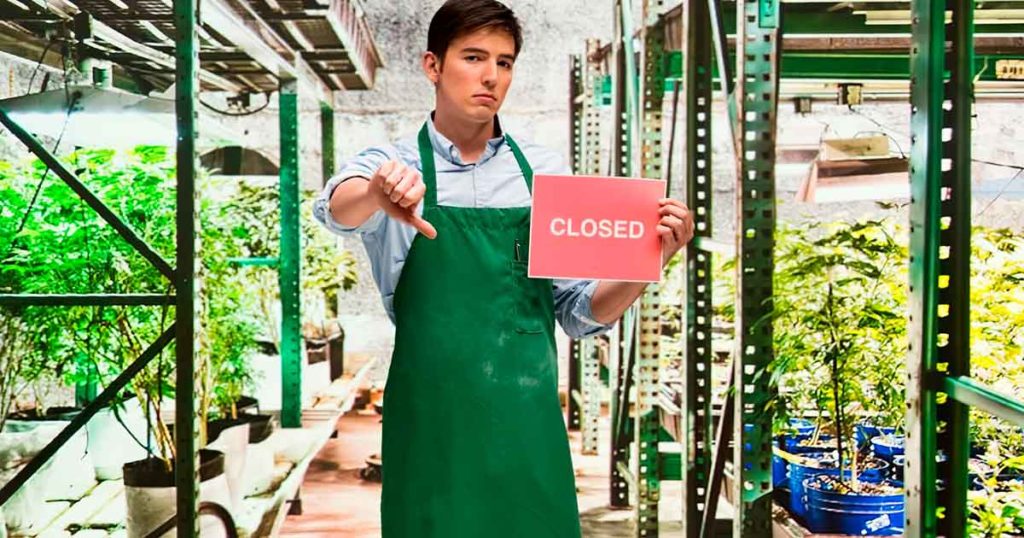The unprecedented storms that pounded California have had a widespread impact on cannabis operators across the state, interrupting operations and possibly supplies. As the coast has been battered by days of high winds and disastrous rains, some marijuana companies have temporarily ceased operations and shored up their buildings desperately to mitigate the damage.
Several firms have reported that their activities have been inundated, resulting in enormous economic losses. Others have reported product losses due to crop damage caused by heavy rainfall. Power outages have also disrupted production processes, leaving factories vulnerable to mildew and other pollutants. Several operators have been unable to access their activities due to road restrictions and hazardous weather.
According to Poweroutage.us, about 225,000 residents and businesses were without power on Tuesday. In Santa Clara County, the hub of Silicon Valley, more than a fifth of the outages occurred. Several cannabis-growing counties, including Mendocino, Monterey, and Santa Cruz, saw widespread power disruptions.
Industry Standstill
This storm system, projected to diminish by Tuesday afternoon, is California’s latest climate calamity. A heat wave wrecked and devastated the state’s cannabis industry in late September following another difficult wildfire season.
Workers cannot access cultivation facilities due to washed-out roads, which may result in lost sales and manufacturing delays, including flower packaging and cutting. This, in turn, might disrupt the marijuana supply chain and leave some retail store shelves bare.
The storm began on Sunday and forced tens of thousands to flee and killed at least 15 people across the state. More than 34 million people are under a flood warning. Strong gusts have also blown down trees and cut off power in some areas.
The New York Times reported that areas of Ventura and Santa Barbara counties in central California had gotten more than 16 inches of rain as of Tuesday morning, with additional rain anticipated for the next few days.

A Downpour Of Trouble
Aiden Rafii, the CEO of Euphoric Life, has been unable to commute from San Francisco to his company’s manufacturing site in Monterey County for more than a week due to the extensive road and highway closures. Rafii has been monitoring potential water breaches with security cameras late into the night. After sandbagging all the doorways and entryways, he believed the company had avoided operational and product harm. However, he noticed late Tuesday morning that the electricity went out during a butane extraction run in the Hollister facility, which was beginning to take in water from groundswells.
Meanwhile, the company’s freezers hold approximately 2,800 pounds of fresh frozen biomass. If the material thaws out without power, it will be damaged. Euphoric Life possesses a batch of product worth about $140,000. That will be a significant setback for any corporation.
Euphoric Life’s products are not insured due to the federal marijuana prohibition. Euphoric learnt the hard way a few years back when a thunderstorm washed out around $10,000 in product after water got into the building.
The CEO of cannabis producer and packager Posibl, Jesus Burrola, said that most of his employees have been unable to visit the farm due to flooded roads. Fortunately, one of Burrola’s workers has a lifted pickup that helps him to navigate the mud. However, over 100 manufacturing workers employed by Burrola have been unable to come in for the last two days. Because of the disturbance in the manufacturing process, the brands that rely on his company and have pending orders may run out of stock. Businesses face stockouts since each production hiccup affects the entire supply chain.
According to Michael Katz, executive director of the Mendocino Cannabis Alliance, severe winds could endanger hoop buildings used by several small regional producers, and power outages could disrupt curing and storage operations. According to him, at least one sizeable local company received substantial water, preventing entry to the facility. Due to the inability to deduct typical business expenses, the damage produced by these storms may be difficult for some people to address.
Some Have It Easier
Kristin Nevedal, director of Mendocino County’s Cannabis Department, says warnings have been made to producers working near burn scars left by massive wildfires a few years ago. She says that when faced with heavy rain like today, those burn scars tend to transform into mudslides.
However, many growers in the Emerald Triangle (Humboldt, Mendocino, and Trinity counties) are self-sufficient and can survive without electricity. Nevedal remarked that most rural homesteaders have either alternative energy sources or have figured out how to consume meager quantities of power.
Eric Sklar seemed relieved because his Napa Valley Fumé offices, operational facility, and Lake County cannabis farm had not been damaged during press time. He claimed that the Napa River in adjacent St. Helena nearly crested at 17 feet on Monday morning, triggering flooding.
Natalynne DeLapp, executive director of the Humboldt County Growers Association, stated that some growers were experiencing wind damage as a result of some low-tech infrastructure—plastic being ripped off hoop houses, for example—and roadways were closed due to downed trees. Still, the situation is not as dire as the news suggests.

The Rain In California Is More Than Just A Pain
The health of the cannabis industry is still mainly dependent on the weather. Currently, there are no conclusive metrics to show the extent of crop damage caused by these storms; however, it can be assumed that operations are experiencing a shortage due to a decline in product yield.
It will likely be months before they can resume business, even after the rain has ended and roadways have been cleared. What is clear is that the unprecedented rainstorms brought on by the Pineapple Express storm system had a massive impact on cannabis operations in California. The loss of these agricultural resources has enormously affected consumers, growers, and distributors in these regions.
All in all, it’s a tough time for many of the state’s cannabis operations. These disruptions will likely lead to short-term supply chain challenges and long-term adjustments for producers. While the problems with supply will be substantial, it remains hard to predict the actual outcome.
Enjoyed that first hit? Come chill with us every week at the Friday Sesh for a freshly packed bowl of the week’s best cannabis news!
















